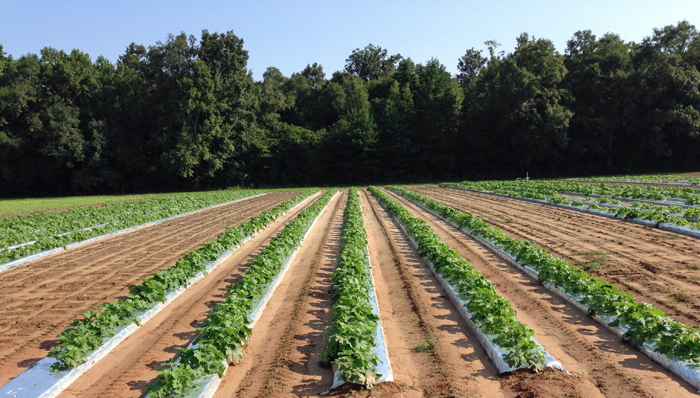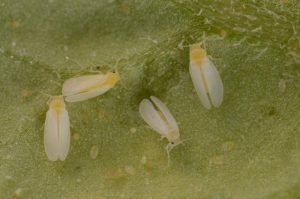
Metalized plasticulture may be a worthwhile investment this fall to disrupt high populations of whiteflies, aphids and thrips that built up from another mild winter. Credit: Josh Freeman
I realize that most vegetable producers have just settled into their spring crops, everything is well on its way, and you can put it on maintenance mode for a few weeks. But before long, if you haven’t already, it will be time to make plans for fall crops. This is where I challenge you to start thinking a little early to be prepared. I don’t’ want to be an alarmist with this article, but I do want you to be prepared. Remember the challenges last fall, mostly in the form of whiteflies and viral diseases? We knew at the end of the fall growing season that if we didn’t have cold winter it could be troublesome for the 2017 growing season, and we didn’t have a cold winter. Thus, it’s time to prepare and potentially do things a little different than maybe you’ve done in the past.
In North Florida and South Georgia the whiteflies never really went away. Scouts reported finding them all winter long in the regions brassica crops, and as of yesterday, they were still there. It’s only a short flight from much of that acreage to our spring cucurbits and fruiting vegetables. Not that I expect them to be a problem in those crops, but they could be the springboard whiteflies need to build populations. Populations are very low right now, but the fact that we’re talking about whiteflies and virus during the spring is a bit concerning, which is why I challenge you to be ready for the fall.
For producers who utilize plasticulutre, consider using metalized plastic which reflects UV light and disrupts host seeking behavior by whiteflies, aphids, and thrips. Metalized plastic can prevent early infestation and virus transmission to young plants which can be debilitating. This strategy is the first line of defense, because heavy whitefly feeding has negative impacts regardless of virus transmission. Metalized plastic also reduces soil temperature, which improves seedling/transplant establishment during the fall season. Metalized plastic is more expensive than the white plastic that is commonly used in the fall, but the benefits of metalized plastic have been demonstrated.
I realize that by the time fall plants are in the ground, most producers have grown tired of dealing with, and putting money into the acreage for the spring crop, but it is critical that the crop is terminated in a timely fashion. Pest populations have often built up over the season, and it is important not to keep a reservoir for pest and disease that can impact you or neighboring producers.
For tomato growers, think about using Tomato Yellow Leaf Curl (TYLC) resistant varieties. It is not a consistent problem we face, but there is strong possibility it could be a yield limiting factor this fall. Unfortunately we don’t typically evaluate these varieties, so we don’t have much data to base variety recommendations on. Two TYLC varieties we tested in 2016 were ‘Camaro’, and ‘Grand Marshall’ and both yielded very well. Other TYLC resistant varieties are ‘Tribute’, ‘Everglade’, ‘Skyway 687’, ‘SecuriTY 28’, ‘Seven TYIII’, and ‘Charger’ (disclaimer, this is not a complete list or an endorsement of any of these varieties).
Insecticides are another tactic that can be used to manage whiteflies. Labeled insecticides can be found for most vegetable crops in The Vegetable Production Handbook of Florida. It is critical that insecticide modes of action be rotated. The mode of action is listed in the production guide, and on the pesticide label. Whiteflies are prone to developing insecticide resistance. There is only a limited number insecticides that are effective against whiteflies, so we must do everything possible to be good stewards of these tools.
This article is intended to be a primer and is in no way a management guide for whiteflies. Listed below are several articles that are dedicated to whitefly and virus disease management. Whiteflies and viral diseases may not be an issue this fall, and that would be positive for everyone, but I believe we should prepare for the worst and hope for the best.
Management of Whiteflies, Whitefly-Vectored Plant Virus, and Insecticide Resistance for Vegetable Production
Recommendations for Management of Whiteflies, Whitefly-Transmitted Viruses, and Insecticide Resistance for Production of Cucurbit Crops in Florida
2016-17 Vegetable Production Handbook of Florida
- NFREC Faculty Tribute to Arnie Forrester - February 11, 2022
- Tomato Varieties for 2022 - January 28, 2022
- Pumpkin Production in North Florida - July 30, 2021

